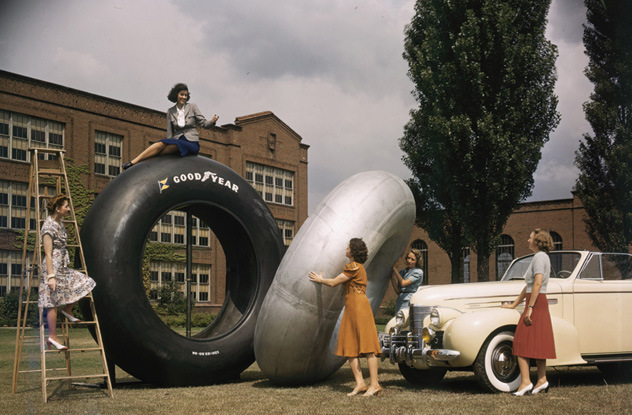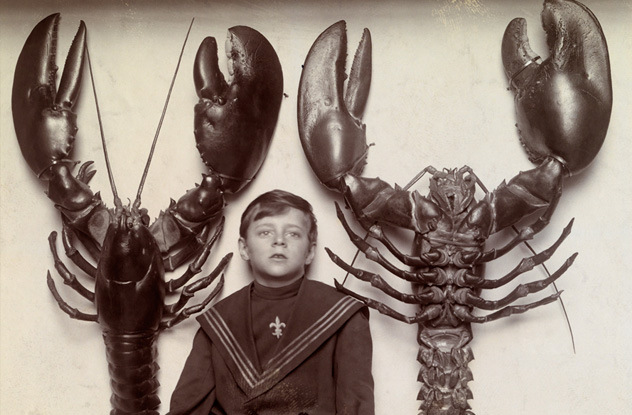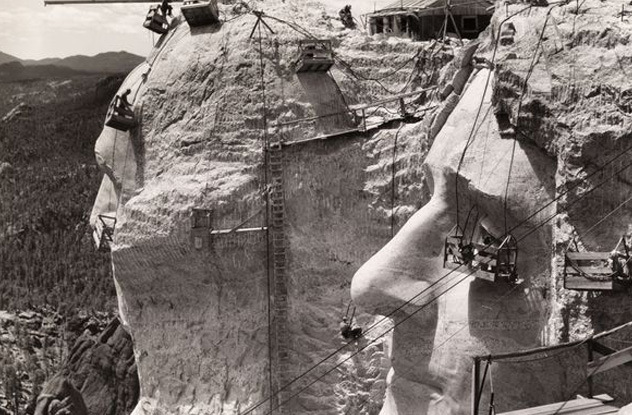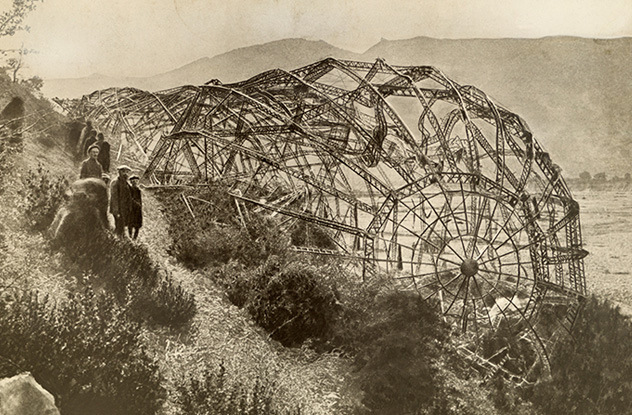It's easy to believe that we live in the age of the bigger and better, and in many cases, that's true. But one thing you can't discount is history's ability to overwhelm us when we least expect it. From the manmade to the natural, these photos capture the essence of what it means to feel insignificant.
人们普遍认为,我们生活在一个更大、更好的时代,多数情况下也确实如此。但不得不承认的是,历史上也有许许多多的东西总在不经意间让我们大跌眼镜、叹为观止,无论是"人造"的还是"纯天然"的,以下的照片都足以让我们感受到自己的微不足道。
10.Dr. Bahnson's Lily Pads
10.班森博士的睡莲叶子

Dr. George Frederic Bahnson was a man of many talents. He was one of the most acclaimed medical diagnosticians in his time, he served as a Union sharpshooter in the Civil War, and he grew the biggest lily pads the US had ever seen.
乔治·弗雷德里克·班森博士是一个集众多才能于一身的人。他是当时最负盛名的内科医生,也曾作为联盟神枪手参加了美国内战。此外,他还成功培育出了当时美国史上最大的睡莲。
The photo above is a surreal endorsement for the potential of any man with a modest green thumb and a teaspoonful of insanity. In his years after the war, Bahnson and his wife worked tirelessly to cultivate the Victoria Regal water lily, an Amazonian species known to reach widths of over 2.5 meters (8 ft) in the wild. The Bahnson duo became the first people to grow it in the US without the help of a greenhouse. The pond that housed this odd little piece of history was later drained to make way for the Salem College Fine Arts Center.
他谦逊有礼,极具潜力,在园艺方面技艺卓著,有时还被人误以为有"一丝精神错乱",但这幅看似奇怪的照片,恰恰是对他才能的极大认可。在战争结束后的那些年,班森和他的妻子不辞辛苦地致力于培育维多利亚大王莲(又称维多利亚亚马逊睡莲)。该睡莲原产于南美洲亚马逊河流域,野生的此种睡莲直径可超2.5米(8英尺),因而闻名于世。班森夫妇是在美国于非温室条件下成功种植该睡莲的先驱。不过,当年用于种植这一神奇之物的池塘后来被抽干,并用于建造如今的萨利姆学院美术中心。
9.The Antarctic Snow Cruiser
9.南极雪地巡航车

By the 1940s, Antarctic exploration mania was reaching a fever pitch. Fueled by the exploits of Shackleton, Falcon, and Charcot, the world watched with breath held and fingers tensed as each new team forged a path through the frozen southern wastes. In an effort to keep up with the spirit of discovery, new and better technologies were rolling off the assembly lines to help these heroic men better cope with the elements.
20世纪40年代,人们对于南极探险的狂热近乎白热化。而在沙克尔顿,法尔肯和沙可等先驱的推动下,一支又一支探险队伍踏上了南极这片人迹罕至的冻土。每一次探险都牵动着全世界人民的心,人们不禁屏住呼吸、攥紧手指,密切注视着探险进程。多年来,为了努力配得上人们的探索精神,科学家们研发出了许多更新、更好的技术,以帮助那些勇者更好地应对南极探索中的各种困难。
One of these innovations was the Antarctic Snow Cruiser. Designed by Dr. Thomas C. Poulter, an Antarctic veteran with the lung damage to prove it, the Cruiser was supposed to be the epitome of exploration technology. It had specially designed treadless tires that were supposed to be able to bridge the wide crevasses that had prevented past explorers from using vehicles. After months of development, the Cruiser touched Antarctic ice for the first time on January 15, 1940, at the Bay of Whales. For a brief and glorious moment, it perched on the permafrost like a fierce metal penguin, and then the massive tires broke through the snow and spun out. The crew dug it out, only to have the engines overheat a few hundred meters farther in. Thus began the most frustrating months humans have ever experienced in Antarctica.Eventually, the expedition decided to simply cover the Snow Cruiser with timber and use it as a glorified tent. It was abandoned when the team left Antarctica early the next year.
其中一个重大创新便是南极雪地巡航车。该巡航车由患有肺病的南极探险老将托马斯·C·普尔特博士设计,作为标志着南极勘探技术实现新飞跃的里程碑,它当之无愧。它的轮胎被特地设计成无防滑纹式,以弥补过去因冰面缝隙过大造成的车辆无法跨越的难题。经过数月的研究改进,南极雪地巡航车于1940年1月15日在威尔士湾登陆,首次踏上了南极这片白雪皑皑的土地。有那么短暂而辉煌的一刻,它像一只凶猛的金属企鹅栖息在这片永久冻土之上。随后,巨大的轮胎破开层层积雪,却不料深陷其中无法行进。探险队员们将它从雪地中挖了出来,重新发动引擎,也不过是多行进了几百米就再次罢工(还全是倒着开的)。至此,人类开始了在南极长达数月的、最为艰难的探险之旅。最终,探险队决定用木料简单地覆盖雪地巡航车并将其用作"荣耀帐篷",供队员们休憩。翌年年初,探险队动身离开南极,雪地巡航车也随之被遗弃在那儿。
8.美国龙虾

The general consensus on lobsters is that they're almost too big to fit on a dinner plate but not quite. At an intellectual level, we realize that they get a lot bigger than the ones at the grocery store, but this photo hammers that understanding home with visceral enthusiasm. Although these aren't the largest lobsters on record—that distinction goes to a beast caught off Novia Scotia that weighed in at 20 kilograms (44 lb)—each of their claws is bigger than the boy's torso, giving yet another argument for staying out of New Jersey's water.
人们普遍认为龙虾最大能大到连一个餐盘都装不下,但事实远非如此。从观念层面上来看,人们都知道它们比杂货铺里卖的龙虾要更大,但是这张照片里的龙虾个头彻底颠覆了人们的原有认知,因为它实在太大了。尽管图片中的龙虾并不是记载中最大的(从新斯科舍外海捕捞上来的龙虾都重达20公斤(44磅)),但它们的每只爪螯都要比一个男孩的身体还大,这也就再次给出了它们避开新泽西州水域生活的理由——新泽西州水域较浅、缺氧,不适合此类龙虾生存。
The American Northeast is no stranger to clawed beasts of the deep. The growth of the American lobster industry paralleled the advent of canning technology in North America, and by the middle of the 19th century, demand for lobsters was skyrocketing. Supply quickly rose to meet that demand to the point. The northeast got so inundated with lobster meat that it came to be considered a "poor man's food." That's obviously changed by now, although lobster fisheries the world over still pull in over 200,000 tons of this particular decapodian delicacy every year.
这些在水域深处生存的大龙虾对美国东北部环境并不陌生。美国龙虾业的发展与北美罐头加工业的兴起很是相似。在19世纪中期,人们对龙虾的需求飞涨,供给迅速上升到需求的对应点。而东北部的龙虾肉很快泛滥,因此被称为"穷人的食物"。虽然如今全世界的龙虾养殖场每年仍能捕获超过20万吨的"美味佳肴",但这种供大于求的情况已得到明显改善。
7.The Carving Of Rushmore
7.拉什莫尔山雕像

This photo from the construction of Mount Rushmore was taken in the late '30s, just a few years before the monument's completion in 1941. The project was absolutely immense in scope, especially considering that it was built on the heels of the Great Depression.
这张总统山的建造图片拍摄于上世纪三十年代末,恰好就在1941年,即纪念碑竣工的前几年。在当时经济大萧条的背景下,这个工程更是显得空前巨大、史无前例。
Like ants on an action figure, workers spent 14 years clinging to the nostrils and eyebrows of America's greatest presidents. Using steel cables and massive winches housed in buildings at the top of the mountain, 30 men at any given time first blasted then carved the monument out of Rushmore's granite face. Dynamite charges carved out the features to within 8 centimeters (3 in), after which workers hand-carved the rest with what became known as the honeycomb method. Using jackhammers, workers bored a series of closely spaced holes, which were then knocked away with a chisel. The only person who died during the construction of Mount Rushmore was its architect, Gutzon Borglum, who died of natural causes six months before it was finished.
工人们在山体上动工,与庞大的山体相比,显得那样渺小,就像蚂蚁爬在仿真人偶上一样。他们花了14年的时间钉凿出美国最伟大的总统们的鼻子和眉毛。工人们把钢丝绳和巨大的绞车安置在山顶的建筑物上,且在给定的时间内派出三十人先去爆破,然后再去把人像雕刻在拉什莫尔山的花岗岩岩体表面。工人们先用炸药炸出8厘米(3英寸)左右的轮廓,之后再手工雕刻其余部分,这就是为大家熟知的蜂窝法(短柱式采矿法)——工人们先用手提钻钻出一系列的紧密细孔,然后再用凿子敲开。在总统山的建造过程中,唯一死去的人是建筑师格曾·博格勒姆,他在工程完工前六个月因自然原因死亡。
6.齐柏林飞艇遗骸

Thanks in part to the Hindenburg, the early, hydrogen-filled Zeppelins are now synonymous with flaming tragedy. In World War I, 84 Zeppelins were built for the German wartime effort. Sixty of them were destroyed, and about half of those losses weren't even from enemy fire—they were just accidents.
拜"兴登堡号空难"所赐,早年间利用氢气气囊作为动力飞行的齐柏林飞艇如今成为了"坠毁悲剧"的代名词。在第一次世界大战中,德国共建造84艘齐柏林飞艇投入战争,最终损失了60艘,其中半数都毁于意外而非敌人的枪炮轰击。
In the aftermath of the various bombing raids that never seemed to do much damage, European countrysides became impromptu grave sites for the burned-out carcasses of these massive airborne leviathans. The photo above was taken in Mison, France in 1918. Our closest modern equivalent to these large-scale wreckages would probably be underwater shipwrecks, but even those rarely come close to the size of the largest airships of the era.
以上这张照片于1918年摄于法国米松(Mison)。敌人的轰炸都没给德军造成多少损失,但这些空中的庞然大物倒被意外引起的大火烧了个一干二净,它们巨大的残骸散落在欧洲乡间的土地上,使这里变成了飞艇的临时"停尸场"。现如今,在外形大小上能与这些庞然大物比拟的,大概也就只有那些沉入海底的巨轮了,但如果拿它们同当年最大的齐柏林飞艇相比,这些"海上霸主"也会相形见绌。

















